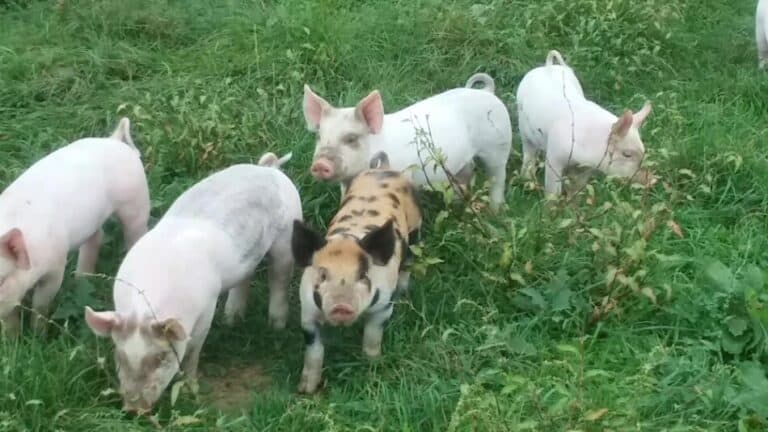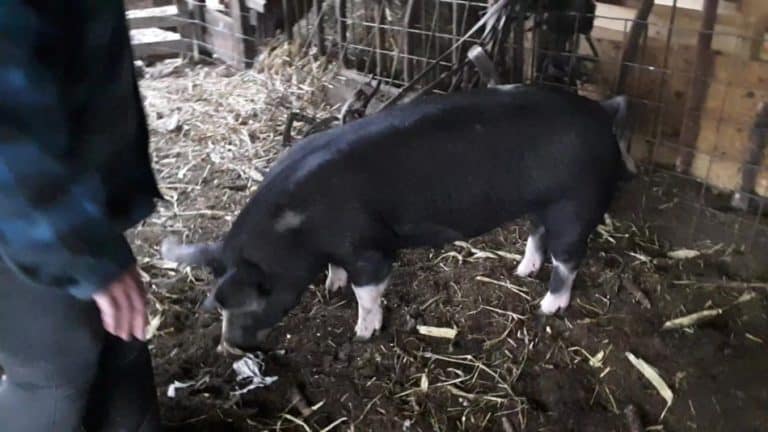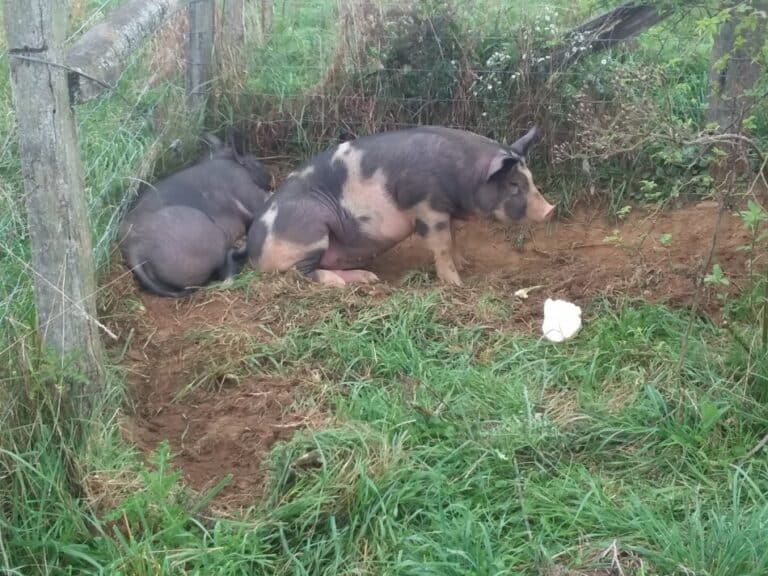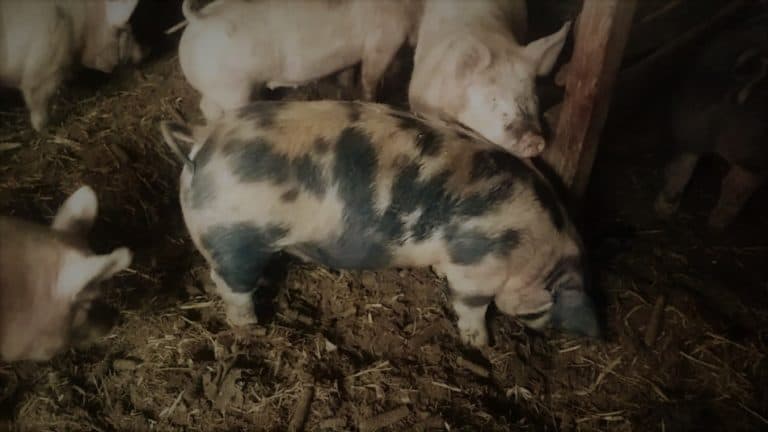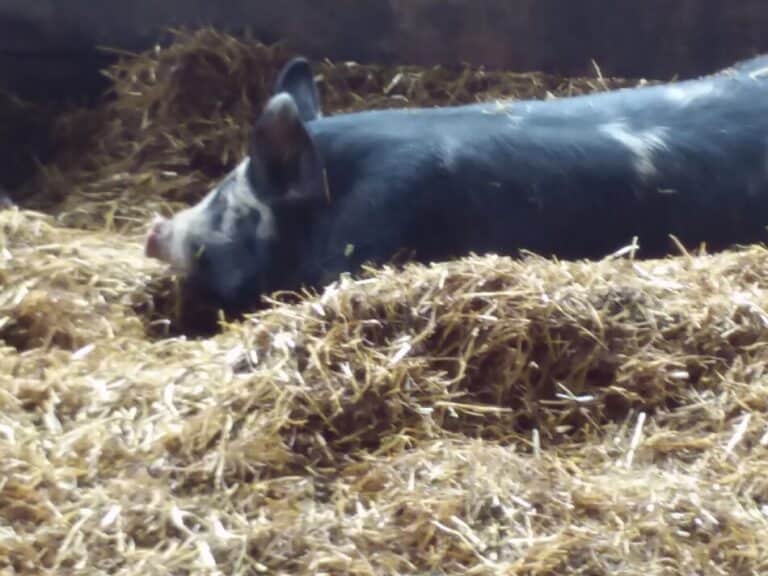Home Raised Pork: What Are The Butchering Costs?
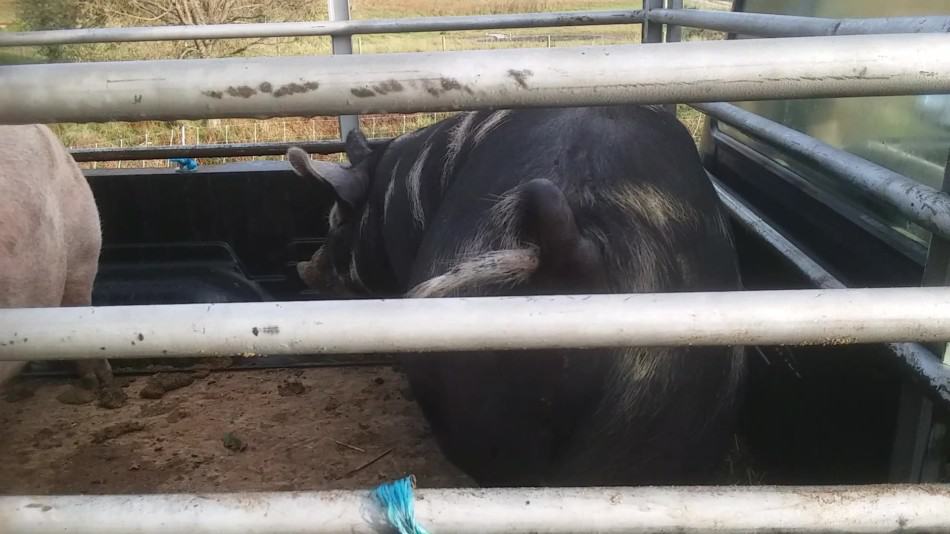
| What you are paying for | Cost |
| Slaughter fee for pigs less than 300 pounds | $100/each |
| Slaughter fee for pigs more than 300 pounds | $0.60/pound |
| Curing and smoking | $0.70/pound |
| Organic | $0.30/pound |
| Stuffed Sausage | $0.40/pound |
| Bratwurst (10 flavor mixes to choose from) | $0.70/pound |
| Breakfast Links | $1.00/pound |
| Smoked Sausage | $1.35/pound |
Thinking about raising your own pork? It will be worth doing for the taste, alone, since you’ll get much more flavorful meat than the stuff in the store!
Now, the big question: What is getting all of that amazing meat into your freezer going to cost you?
Butchering costs for a pig are $100 for the slaughter fee plus $0.40-1.35 per pound for cuts that need additional handling and time to fill your order, like bratwurst or curing and smoking.
Congratulations! Raising your own meat gives you a huge jump up in taste (you’ll love it!) and peace of mind-you know exactly what went into that pig and how it was treated.
Plus, when you open up that freezer door and see all that meat-that’s a bit of security for you and your family.
Not to mention how awesome it feels to serve some of your home grown pork to close friends or at a family gathering. You share your best with the people you love!
When Is Your Pig Ready To Butcher? will show you exactly how to tell when your pig is “finished”, meaning that your pig is well grown and has an appropriate covering of fat.
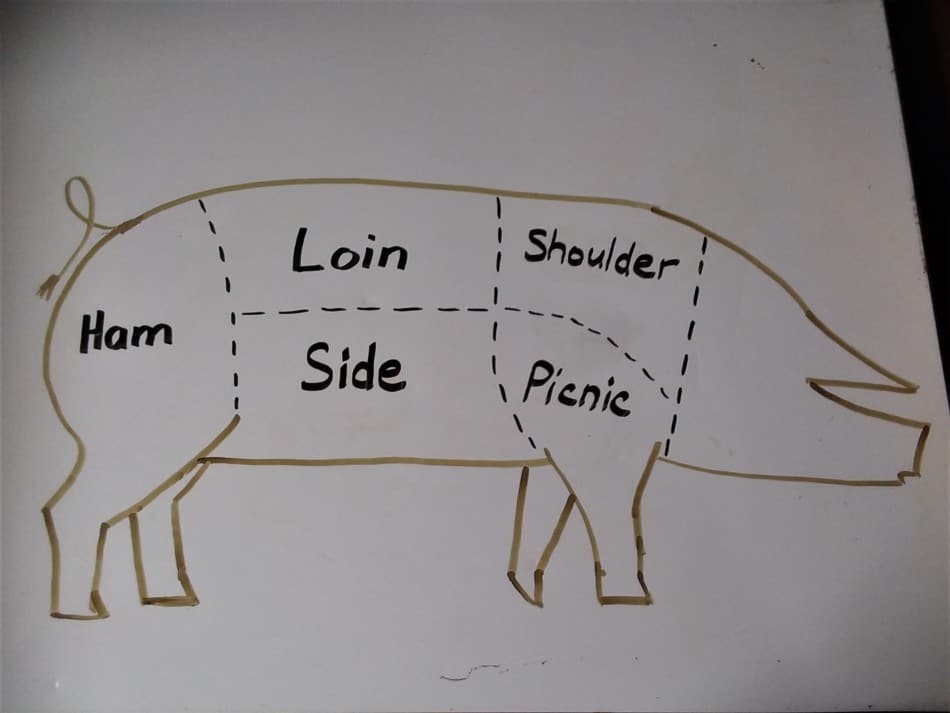
Basic butchering costs for pigs are priced per pound
The differences in price per pound in the table above are based on the additional work Turk’s (our local slaughter house) has to put in to get the meat to your specifications.
Keep in mind it is possible to double up on charges.
For instance, if you wanted your meat processed organically and done as smoked sausage you will be charged for both parts, the organic part and the smoked sausage part, per pound.
You can see price per pound varies significantly among the different choices, the lowest being $0.30/pound and the highest being $1.35/pound.
What’s the deal? A few examples with explanations of each will help clarify the pricing structure.
A few examples:
- Breakfast links cost more per pound than larger sausage links, like bratwurst. Why? The breakfast links are smaller, making a pound take longer to put into the casing and taking more casing length per pound.
- Smoked sausage costs more than any other option. Why? The smoked sausage has to be put in the casing first (stuffed) then kept separate from the rest of your order while it is smoked. This multiple step process takes more time and work on the part of the slaughter house, so you pay more for the extra time Turk’s put in to fill your order to your specifications.
- Organically processed meat has additional specifications to meet the Organic standards. Once again, it’s all about the time to get your order finished to your specifications. More work per pound=higher cost for you.
Your local slaughter house might figure prices a bit differently. No worries.
From what I’ve seen, the results end up with about the same total cost to you no matter what specifically was figured into the price per pound.
I’m sure prices vary quite a bit from region to region, but in a reasonable driving distance from your house the costs to you will be similar no matter where you decide to go.
Run some numbers yourself, if you don’t like what you see, call a different place.
Where did I get these prices?
The local butcher shop we have always used is Turk Brothers Meats in Ashland, Ohio. Here’s a link to their site, if you want to check it out Turk Brothers Meats.
They have a complete processing price list organized by each species they routinely process.
When I was looking for a price list I naturally thought of them, since every time we have gotten meat back from them it has been processed exactly as ordered and on time.
There are other slaughter houses in the area, we are fortunate to have plenty of options in this part of Ohio. Turk’s is the one I can personally speak about, so that is the price reference I chose to use.
Pig butchering costs can be based on hanging weight
I have just come across an additional pricing structure for custom butchering, which is new to me. This is a slaughter house in our area, 3-D Meats that prices custom pig butchering by hanging weight.
Hanging weight price does make sense, it would be easy to keep track of and eliminate doing a lot of extra weighing to process your pork according to your order.
Hanging weight is the carcass with head, skin, feet and guts removed. This is the part of the carcass that hangs in the cooler to chill after slaughter.
Generally, hanging weight is 70% of live weight. This business is charging $1.45 per pound as of March 2021.
For example, if your pig weighs 300 pounds live, the hanging weight will be around 210 pounds. (300 x 70%=210)
Then 210 pounds hanging weight x $1.45=$304.50
There are additional costs you may not have considered, like hauling
Other costs you may not have considered are going to be hauling, if you are not transporting the pig yourself, and storage of the meat once you get it home.
Scheduling a hauler to come and get your pigs is pretty easy, most just run their hauling business with their cell phone.
How to find a hauler? Ask at the feed store or the local livestock auction. Most auctions have a list of haulers who are looking for more customers.
Another option is to stop in and ask a small farmer.
We have racks on the truck for smaller animals, like sheep and pigs. If we want to send some cattle or more than 2 or 3 pigs we need a hauler, too.
Ask around, haulers are out there.
What about freezer space for the pork?
Do you have the space to put this meat? I have to admit, this is where you might blow your budget for the saving money on meat thing, this time.
However, once you have the freezer, you will not have to buy another for years, so all the pork from here on out has plenty of freezer space.
How Much Freezer Space For My Pig? goes over figuring out what you need to store your pork and shows you how to figure up the open space in a half full/half empty freezer.
I just checked the prices online for chest freezers: 24.8 cu/ft $648.00 and 14.8 cu/ft $398.00. Your pork will fit in either one.
Let’s see how this math works out: if your total processing costs are $125.00 (you had $25.00 of sausage made+$100.00 slaughter fee) and you buy the $398.00 freezer for a total cost of $523.00.
$125.00 + $398.00 = $523.00
You’ll get about 144 pounds of meat from your pig so divide the cost of processing and the freezer by the pounds of meat
$523 divided by 144 = $3.63/pound
That’s $3.63/pound of meat with the processing and the freezer costs included.
Now the freezer is paid for, so next time you butcher your pig (and every time after that for the life of the freezer) this cost per pound will be $0.87!
I’ll admit this figure does not include the cost of getting or raising the pig or the electricity for the freezer. And, I did the figures with the smaller freezer, you might choose the larger one, instead.
Your costs to put in and things to leave out will be different. No matter what costs you choose to use, do the math for you, so you’ll know your options.
What are your butchering options?
The main sections shown in the diagram below are called the primals. The primals are written in black.
Each primal can be broken down in a variety of ways, depending on what you want in your freezer.
Note-Some people refer to the primals by slightly different terms than I have shown here.
For example: listing Boston Shoulder instead of Shoulder or Leg instead of Ham. Nothing to worry about, these are just differing popular terms.
The location on the pig and the common ways to cut and cook it remain the same, no matter the name used.

Kind of know what you’re doing? Start here
Look up a standard cut sheet, the order sheet with all of the cuts available for your pork. I looked up Hog Butchering Cut Sheet and just picked one of the many results.
This is an example of a whole hog cut sheet from Fauquier’s Finest Meats of VA. The cut sheet is the order form the butcher will use to take your pork cutting order instructions.
New or confused about your cutting options? Start here
Need a bit more clarity on exactly what comes from where? Here is a good explanation of the choices you will have Cut Sheets from Fauquier’s Meats, again.
Scroll down for pigs (the list starts with sheep and goats and pigs are next) and note at the very bottom this slaughter house has prices listed as well.
Even if this is not the exact cut sheet your butcher uses, it will be close enough for you to get started.
Some things to consider before you order
What do you and your family eat the most of? When you are giving the processing instructions, ask about the cuts you want the most before anything else.
The slaughter house will have a standard cut sheet, a generic “I don’t know what to order” order. You can always go with that.
It will give you a nice selection of cuts to experiment with at home, so you can fine tune your choices for the next pig you raise.
Questions you will be asked about your order
- You’ll be asked how many cuts per package and how thick you want them.
- Do you want the ham kept whole? Yes, if you want cured and smoked ham.
- Do you want the bulk sausage in links/stuffed or in patties or just bulk? Stuffed means in a casing otherwise it is loose like ground pork.
- What flavoring mix do you want with your bratwurst? Most places will have a few choices.
- How many pounds of bulk (not links) sausage do you want per package? There will always be at least some sausage.
There are no right or wrong answers here, get what you like the best. I like bigger sized packages and less plastic and Styrofoam for the trash, so I order accordingly.
As far as ground meat goes, sausage or just ground pork (no flavoring), I like to get it in bigger packages than one pound.
It just works better for us and uses less packaging. Think about what you normally cook with and order accordingly.
You could also request a portion to be done differently, like 10 one pound packages of bulk sausage and the rest in 2 pound packages.
Or half of the sausage in one pound bulk packages the rest as patties in 5 pound boxes.
Regarding the flavored sausages, like bratwurst, there will be a minimum poundage needed.
Why? The spice/curing mix the butcher uses will come in measured amounts based on pounds of ground pork to be added.
This may be 5, 10, or 25 pound increments, it just depends on what the butcher has to use.
If the poundage requirement doesn’t suit you, you can get the pork ground only (no flavorings added) and mix in spices at home.
There are scads of recipes for this kind of stuff online and/or mixes to buy online or at your local hunting supply store. Of course, that will mean you are putting it in the casings, as well.
If you don’t want a specific cut of pork, say so
If the butcher asks about a cut you don’t want, say you don’t want it. No worries, that meat won’t be thrown away.
What will happen to it? If possible, the rest of the cutting will be adjusted. Otherwise, it will most likely be put into the sausage.
This is your pig, get what you want! The only person you need to please here is you. I prioritize bacon, pork chops and ham over all other cuts.
I really don’t use too many roasts. (Until I figure out a smoker, then I’ll be all about roast pork!) I’m happy with the rest of the meat as sausage.
That’s what works best for us. What works best for you?
If you don’t like the pressure of making in the moment decisions, stop by the slaughter house and ask for the order cutting sheet to study (or click the link above to see one online).
Take it home and look over your options.
The first time I placed an order, I was completely unprepared for the questions. I’m embarrassed to say, I had no idea what my choices would be so it took a while. Thankfully, Turk’s was patient!
How do you set a butchering appointment?
Call the slaughter house and see what openings they have available for your number of pigs. Call ahead, like months ahead.
In the fall, or whenever butchering is normally done in your area, the appointment book will fill up fast.
Occasionally, there are surprise openings for appointments due to a cancellation, but don’t count on it. Schedule early!
Can we butcher our own pig at home?
You sure can butcher your own pig at home! This is what we do and it’s easier than we thought.
If you are a deer hunter, no worries, you’ve got this! If you aren’t, find a friend who is to help you out.
The biggest difference between the deer and a pig is that a deer can be manhandled into place and hoisted to hang by people power.
A pig carcass is going to be too heavy for that. Be sure to have a loader bucket and chains (not rope!) handy to raise the pig.
Hang the carcass overnight then cut and process the next day
We just put one of my pigs in the freezer earlier this week. We hung the carcass overnight to chill then cut and packaged the next day.
Pick a day where the weather is working for you, cooling the meat overnight and decent to be out in the next day to break down the carcass. We cut the primals off the carcass then carry them into the house to work on the counters.
It took us a total of just over 3 hours, one hour to get the pig hung, skinned and gutted on Monday night, then just over 2 hours of cutting and processing on Tuesday morning.
We put a total of 123 pounds of boneless pork in the freezer in that 2 hours with just a knife, zip close freezer bags, a grinder and a decent amount of counter space to work off of.
We are definitely not professionals, with a little practice you can do this, too.
Check out my article When Is Your Pig Ready To Butcher? I’ve embedded one of my videos so you can see on one of our pigs what I’m talking about in the article.
New to home butchering? Get a mentor
If you have no experience butchering larger stock, get some help from someone who can guide you through the steps. Once again, it’s not hard.
It’s reassuring to have a person with experience guiding you, who can answer “Is this normal?” and “Am I doing this right?”
There are just a few steps that are much easier if done in a timely matter-like skinning while the carcass is still warm (tons easier!)
Other steps can be done as you choose, like cutting up the carcass-most people don’t hang a pig to age but you easily could.
There are quite a few videos online showing how to butcher a pig at home. Not everyone hangs the pig, we do.
Watch a few different people and see which way you think will work best for you using supplies you already have at home.
If you want to sell some of the meat
If you want to sell individual cuts of meat: you’ll need to have a label set up through your state department of agriculture for retail sales.
The paperwork must be done months in advance of your planned packaging date.
The meat will also have to be slaughtered at an approved facility and a federal facility if you want to sell across state lines.
If you want to sell half of a hog: this is more common since there is no labeling involved, so no paperwork.
Why doesn’t half a pig need labeling like retail cuts do? The customer purchased half of a live hog from you, not a specific poundage of pork.
The customer was the owner when the pig was still on the hoof. Butchering your own animal does not require labeling, unless you are selling the cuts.
Tell the butcher that half of this pig is going to someone else and give the name and contact information for the slaughter house to get the other person’s cutting instructions.
The butcher will split the hog carcass right down the center and treat each half as a separate order.
Another option would be a quarter hog, but tread carefully here. Everyone will want the back half and no one will want the front half.
To keep this from happening, most people that sell quarters (pork or beef), do a split quarter.
Meaning the hog is cut up as a half hog then all the cuts are split between two customers, “one pork chop for you, one pork chop for me” style.
